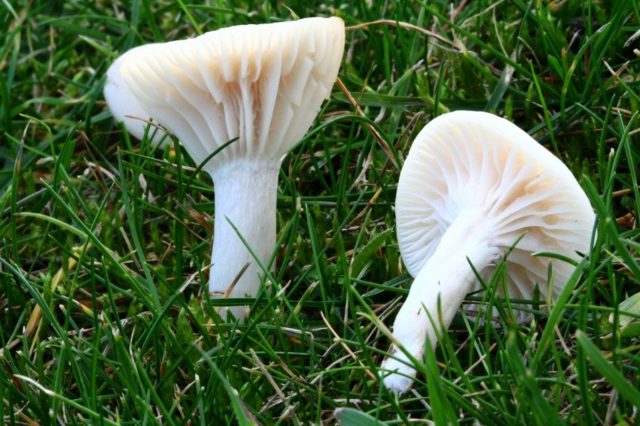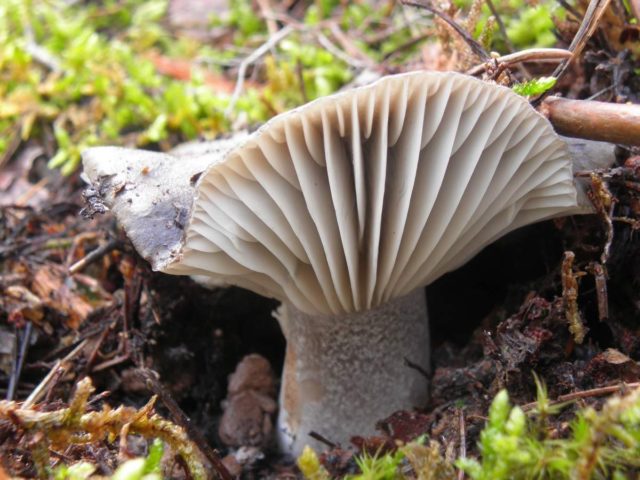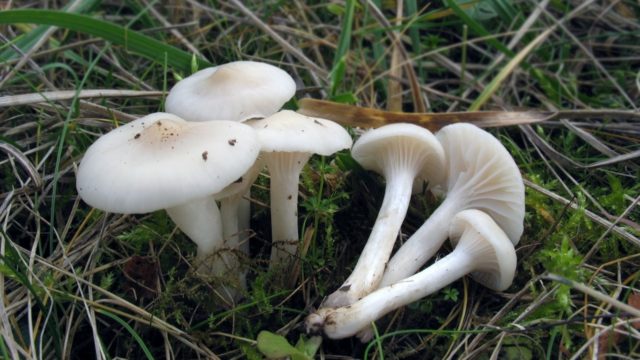Content
Gigrofor snow-white or snow-white belongs to the edible representatives of the Gigroforov family. It grows in open places in small groups. To recognize a mushroom, you need to read the description, know the place and time of growth.
What does a snow-white hygrophor look like?
The snow-white gigrofor can be recognized by the snow-white convex cap, which straightens as it grows, leaving a small tubercle in the middle. The edges are ribbed, transparent due to the thin flesh. The surface is slimy, becomes dull in hot, dry weather. The spore layer is formed by thin whitish plates descending to the pedicle.
The leg is dense, up to 4 cm long. Snow-white, fragile pulp, tasteless and odorless. In case of mechanical damage, the color does not change.
This species reproduces by microscopic, elongated spores that are in a whitish powder.

Due to the fragile pulp, the cap looks transparent
Where does the snow-white hygrophor grow
Gigrofor snow-white prefers to grow in open places. The fungus can be found in tall grass in meadows, pastures, forest glades and within the city. Also, the species can be found in parks, squares, in personal plots.
Is it possible to eat a snow-white hygrophor
The snow-white gigrofor is considered an edible specimen. After heat treatment, it can be fried, canned, stewed and frozen. Also fresh mushroom harvest can be dried for the winter. The dried product is stored in paper or linen bags in a dry, dark place. The shelf life is about 12 months.
False doubles
The snow-white gigrofor has no poisonous counterparts. But in the forest you can find similar fellows that can be eaten. These include:
- Early - occurs in early spring immediately after the snow melts. It grows in deciduous forests in numerous families. You can recognize the species by the snow-white hat, which, as it matures, becomes dark gray or black. The snow-white pulp is tasteless and odorless, but despite this, mushrooms are often used to make mashed soups.
The first mushroom to appear in the forest
- Russula - a rare, edible species that grows in deciduous forests. Grows in small groups, bears fruit from August to October. The fleshy cap of a dark red or dark pink color is slimy; in dry weather it becomes dull. The snow-white pulp exudes a pleasant aroma and has a sweetish taste. Only young specimens are used in cooking.
Dense, tasty and aromatic pulp is suitable for preparing a variety of dishes
- Maiden - a conditionally edible species with a small, convex cap. The surface is covered with a snow-white skin, which is covered with a mucous layer in rainy weather. It grows in open areas, along roads, in clearings and meadows. It bears fruit during the whole warm season. Due to the lack of taste and smell, the mushroom is not of high value, but after heat treatment it can be fried, stewed, pickled and salted.
Grows on fertile soil until the first frost
Collection rules and use
Since the snow-white hygrophor is used in cooking, you need to know the rules of collection and methods of use. Experienced mushroom pickers advise to hunt quietly away from roads and industrial enterprises. Collect in dry, sunny weather in ecologically clean places.
The harvested crop is not subject to long-term storage, therefore, the mushrooms must be processed within 2 hours after harvest. They are carefully examined for damage and worminess. Selected mushrooms are washed and cleaned from forest debris. Before cooking, the snow-white hygrophor is boiled in salted water for 10-15 minutes. Then it can be fried, stewed and preserved for the winter.
Conclusion
Snow white gigrofor is suitable for human consumption. Fruiting in open areas throughout the autumn period. After heat treatment, it is suitable for preparing mushroom dishes and preparations for the winter. In order not to be mistaken during a quiet hunt, you need to know what the view looks like, view photos and videos.











